
WEATHER FORECASTS
National Institute of Meteorology and Hydrology
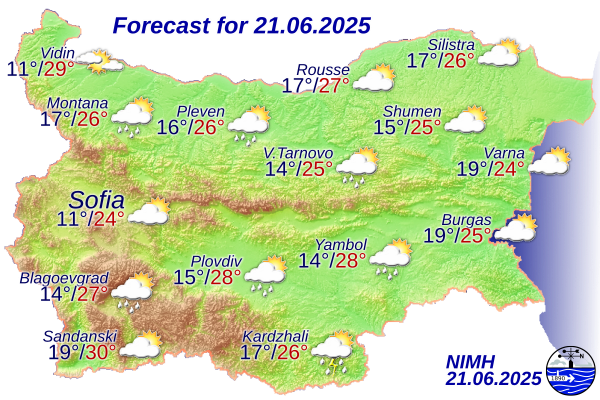
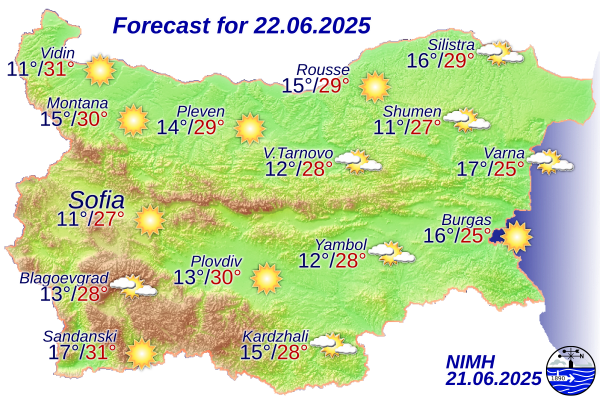
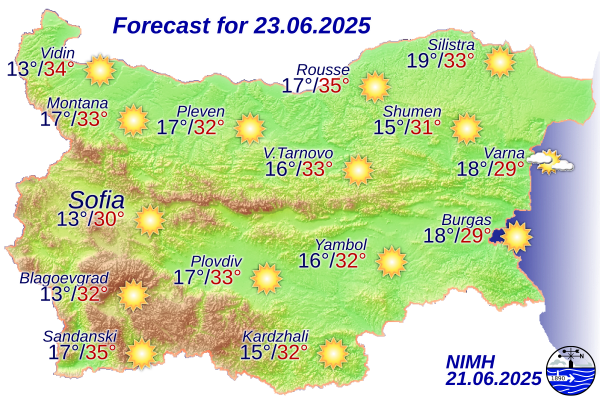
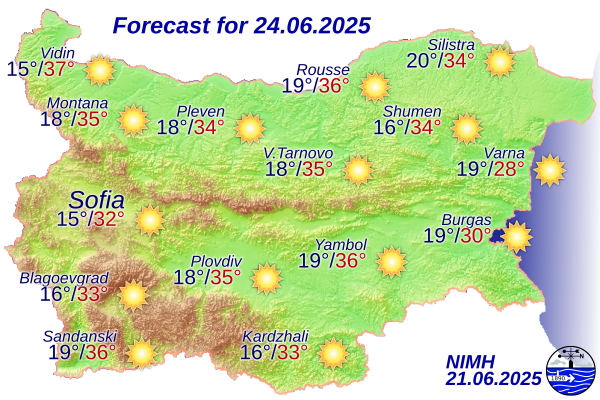
| City | 08.12.2025 | 09.12.2025 | 10.12.2025 | 11.12.2025 | ||||
|---|---|---|---|---|---|---|---|---|
| tmin / tmax [°C] | Weather | tmin / tmax [°C] | Weather | tmin / tmax [°C] | Weather | tmin / tmax [°C] | Weather | |
| Sofia | 4 / 8 |  Mostly cloudy Mostly cloudy |
2 / 9 |  Variable clouds Variable clouds |
2 / 12 |  Variable clouds Variable clouds |
2 / 13 |  Mostly sunny Mostly sunny |
| Sofia district | 3 / 9 |  Variable clouds Variable clouds |
0 / 10 |  Variable clouds Variable clouds |
1 / 13 |  Mostly sunny Mostly sunny |
1 / 14 |  Mostly sunny Mostly sunny |
| Vidin | 2 / 12 |  Mostly cloudy Mostly cloudy |
1 / 5 |  Mostly cloudy Mostly cloudy |
2 / 8 |  Mostly cloudy Mostly cloudy |
2 / 10 |  Mostly cloudy Mostly cloudy |
| Vratsa | 3 / 9 |  Mostly cloudy Mostly cloudy |
2 / 10 |  Mostly cloudy Mostly cloudy |
2 / 14 |  Mostly sunny Mostly sunny |
4 / 14 |  Mostly sunny Mostly sunny |
| Montana | 4 / 10 |  Mostly cloudy Mostly cloudy |
2 / 8 |  Mostly cloudy Mostly cloudy |
2 / 12 |  Mostly sunny Mostly sunny |
3 / 11 |  Mostly cloudy Mostly cloudy |
| Pleven | 3 / 9 |  Overcast Overcast |
3 / 8 |  Mostly cloudy Mostly cloudy |
3 / 13 |  Mostly cloudy Mostly cloudy |
4 / 13 |  Variable clouds Variable clouds |
| Veliko Tarnovo | 4 / 7 |  Overcast Overcast |
4 / 10 |  Variable clouds Variable clouds |
1 / 12 |  Mostly sunny Mostly sunny |
3 / 12 |  Variable clouds Variable clouds |
| Russe | 5 / 6 |  Overcast Overcast |
4 / 8 |  Overcast Overcast |
3 / 10 |  Variable clouds Variable clouds |
4 / 9 |  Mostly cloudy Mostly cloudy |
| Shumen | 4 / 6 |  Overcast Overcast |
3 / 7 |  Overcast Overcast |
0 / 12 |  Mostly sunny Mostly sunny |
2 / 10 |  Mostly cloudy Mostly cloudy |
| Silistra | 5 / 6 |  Overcast Overcast |
4 / 7 |  Mostly cloudy Mostly cloudy |
4 / 10 |  Mostly cloudy Mostly cloudy |
4 / 10 |  Fog Fog |
| Varna | 5 / 8 |  Weak rain Weak rain |
5 / 10 |  Mostly cloudy Mostly cloudy |
4 / 12 |  Mostly cloudy Mostly cloudy |
5 / 12 |  Variable clouds Variable clouds |
| Bourgas | 6 / 10 |  Mostly cloudy Mostly cloudy |
6 / 10 |  Variable clouds Variable clouds |
6 / 12 |  Variable clouds Variable clouds |
6 / 12 |  Mostly cloudy Mostly cloudy |
| Sliven | 6 / 9 |  Overcast Overcast |
6 / 10 |  Variable clouds Variable clouds |
2 / 10 |  Variable clouds Variable clouds |
3 / 12 |  Variable clouds Variable clouds |
| Stara Zagora | 6 / 10 |  Mostly cloudy Mostly cloudy |
5 / 11 |  Mostly sunny Mostly sunny |
1 / 11 |  Mostly cloudy Mostly cloudy |
1 / 12 |  Variable clouds Variable clouds |
| Plovdiv | 8 / 13 |  Mostly cloudy Mostly cloudy |
4 / 10 |  Mostly sunny Mostly sunny |
3 / 12 |  Mostly cloudy Mostly cloudy |
4 / 12 |  Variable clouds Variable clouds |
| Kardzhali | 6 / 11 |  Mostly cloudy Mostly cloudy |
5 / 11 |  Mostly sunny Mostly sunny |
0 / 12 |  Variable clouds Variable clouds |
2 / 13 |  Variable clouds Variable clouds |
| Blagoevgrad | 6 / 12 |  Mostly cloudy Mostly cloudy |
5 / 10 |  Mostly sunny Mostly sunny |
1 / 10 |  Mostly cloudy Mostly cloudy |
2 / 9 |  Mostly cloudy Mostly cloudy |
| Sandanski | 7 / 13 |  Mostly cloudy Mostly cloudy |
5 / 13 |  Mostly sunny Mostly sunny |
4 / 12 |  Variable clouds Variable clouds |
7 / 14 |  Mostly sunny Mostly sunny |
Mountains
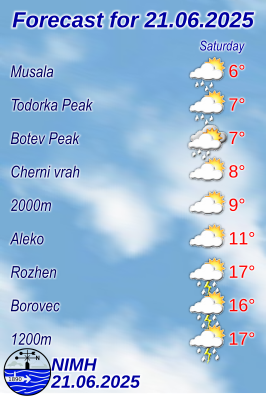
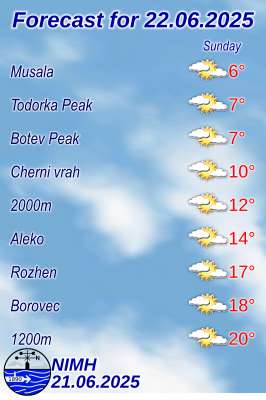
| Point | 08.12.2025 | 09.12.2025 | 10.12.2025 | ||||
|---|---|---|---|---|---|---|---|
| tmin / tmax [°C] |
Snow cover [cm] |
Weather | tmin / tmax [°C] |
Weather | tmin / tmax [°C] |
Weather | |
| Botev peak | -4 / -3 | 29 |  Light snow Light snow |
-4 / 0 |  Mostly sunny Mostly sunny |
-2 / 1 |  Variable clouds Variable clouds |
| Murgash peak | -1 / 1 | n.a. |  Overcast Overcast |
-2 / 3 |  Mostly sunny Mostly sunny |
0 / 5 |  Mostly sunny Mostly sunny |
| Cherni vrah | -3 / -3 | 32 |  Mostly cloudy Mostly cloudy |
-3 / 1 |  Mostly sunny Mostly sunny |
-1 / 2 |  Mostly sunny Mostly sunny |
| Aleko* | -3 / 1 | n.a. |  Mostly cloudy Mostly cloudy |
-3 / 3 |  Mostly sunny Mostly sunny |
-1 / 4 |  Mostly sunny Mostly sunny |
| Musala peak** | -6 / -5 | n.a. |  Mostly cloudy Mostly cloudy |
-7 / -1 |  Mostly sunny Mostly sunny |
-3 / 0 |  Sunny Sunny |
| Borovets* | 0 / 4 | n.a. |  Mostly cloudy Mostly cloudy |
-1 / 6 |  Mostly sunny Mostly sunny |
-1 / 8 |  Mostly sunny Mostly sunny |
| Rozhen | 0 / 3 | n.a. |  Mostly cloudy Mostly cloudy |
-1 / 5 |  Mostly sunny Mostly sunny |
-1 / 8 |  Mostly sunny Mostly sunny |
| Snezhanka* | -3 / 1 | n.a. |  Mostly cloudy Mostly cloudy |
-3 / 3 |  Mostly sunny Mostly sunny |
||
| Pamporovo* | 0 / 4 | n.a. |  Mostly cloudy Mostly cloudy |
-1 / 6 |  Mostly sunny Mostly sunny |
-1 / 9 |  Mostly sunny Mostly sunny |
| Chepelare-Mechi Chal* | 0 / 4 | n.a. |  Mostly cloudy Mostly cloudy |
-2 / 5 |  Mostly sunny Mostly sunny |
||
| Smolyan* | 4 / 8 | n.a. |  Mostly cloudy Mostly cloudy |
4 / 9 |  Mostly sunny Mostly sunny |
-3 / 12 |  Variable clouds Variable clouds |
| Bansko* | 4 / 6 | n.a. |  Mostly cloudy Mostly cloudy |
4 / 9 |  Mostly sunny Mostly sunny |
0 / 10 |  Variable clouds Variable clouds |
| Dobrinishte* | 5 / 7 | n.a. |  Mostly cloudy Mostly cloudy |
4 / 9 |  Mostly sunny Mostly sunny |
0 / 11 |  Variable clouds Variable clouds |
| Todorka peak* | -7 / -4 | n.a. |  Mostly cloudy Mostly cloudy |
-7 / 0 |  Mostly sunny Mostly sunny |
-2 / 1 |  Sunny Sunny |
| 1200m | 1 / 4 | n.a. |  Mostly cloudy Mostly cloudy |
0 / 6 |  Mostly sunny Mostly sunny |
-1 / 9 |  Mostly sunny Mostly sunny |
| 2000m | -3 / 0 | n.a. |  Mostly cloudy Mostly cloudy |
-3 / 2 |  Mostly sunny Mostly sunny |
-1 / 3 |  Mostly sunny Mostly sunny |
* Snow depth information is from the Bulgarian Mountain Rescue Service
** Snow depth not measured.
Note: Snow cover depth is given only during the cold half of the year.
Black Sea
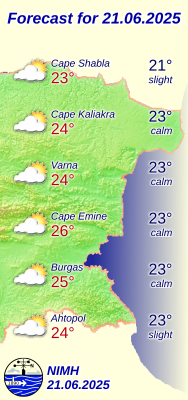
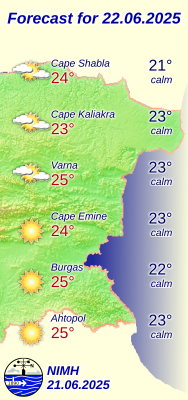
| Point | 08.12.2025 | 09.12.2025 | 10.12.2025 | ||||
|---|---|---|---|---|---|---|---|
| tmin / tmax [°C] |
Water t [°C] |
Weather | tmin / tmax [°C] |
Weather | tmin / tmax [°C] |
Weather | |
| Shabla | 5 / 8 | 13 |  Weak rain Weak rain |
5 / 7 |  Mostly cloudy Mostly cloudy |
7 / 11 |  Variable clouds Variable clouds |
| Kaliakra | 5 / 9 | 14 |  Weak rain Weak rain |
4 / 8 |  Mostly cloudy Mostly cloudy |
8 / 12 |  Mostly sunny Mostly sunny |
| Varna | 5 / 8 | 14 |  Weak rain Weak rain |
5 / 10 |  Mostly cloudy Mostly cloudy |
4 / 12 |  Mostly cloudy Mostly cloudy |
| Emine | 5 / 10 | 14 |  Overcast Overcast |
5 / 10 |  Variable clouds Variable clouds |
8 / 13 |  Mostly sunny Mostly sunny |
| Burgas | 6 / 10 | 15 |  Mostly cloudy Mostly cloudy |
6 / 10 |  Variable clouds Variable clouds |
6 / 12 |  Variable clouds Variable clouds |
| Ahtopol | 6 / 10 | 14 |  Mostly cloudy Mostly cloudy |
6 / 10 |  Variable clouds Variable clouds |
7 / 12 |  Mostly sunny Mostly sunny |
Note: Sea water temperature available only in warm year half.
 Sunny/clear;
Sunny/clear;
 Variable clouds;
Variable clouds;
 Variable clouds; rain possible;
Variable clouds; rain possible;
 Variable clouds; snow possible;
Variable clouds; snow possible;
 Mostly cloudy;
Mostly cloudy;
 Mostly cloudy with rain;
Mostly cloudy with rain;
 Mostly cloudy with snow;
Mostly cloudy with snow;
 Mostly sunny;
Mostly sunny;
 Overcast
Overcast
 Rain;
Rain;
 Short rain showers;
Short rain showers;
 Some showers and thunder;
Some showers and thunder;
 Rain and snow;
Rain and snow;
 Weak snow;
Weak snow;
 Heavy snow;
Heavy snow;
 Fog;
Fog;
 Changeable: sunshine and showers, possible thunder;
Changeable: sunshine and showers, possible thunder;
 Changeable clouds;
Changeable clouds;
 Weak rain;
Weak rain;
 Thunderstorms
Thunderstorms
Preparedness for Firefighting
on the bases of the operational regional weather forecasting model ALADIN-BG
| Степен на риск/ Hazard | Описание на български | Description in English |
| Малък Low | Съществуващи пожари се самозагасяват и е малко вероятно да възникват нови. Жизнени пожари са възможни само като тлеене в дълбоки сухи слоеве. | Fires likely to be self-extinguishing and new ignitions unlikely. Any existing fires limited to smoldering in deep, drier layers. |
| Умерен Moderate | Възможни са леки и бавно развиващи се пожари. Съществуващи пожари се гасят лесно от наземни екипи с помпи и ръчни инструменти. | Creeping or gentle surface fires. Fires easily contained by ground crews with pumps and hand tools. |
| Голям High | Възможни са умерени до силни пожари с въвличане на дървесни корони само локално. Пожарите са трудни за овладяване от наземни екипи. Често се налага използване на тежка екипировка за овладяване на пожарите (булдозери, камиони-цистерни, самолети). | Moderate to vigorous surface fire with intermittent crown involvement. Challenging for ground crews to handle; heavy equipment (bulldozers, tanker trucks, aircraft) often required to contain fire. |
| Много голям Very High | Възможни са много силни пожари с частично или пълно въвличане на дървесните корони. Предните фронтове на пожарите е невъзможно да бъдат овладени от наземни екипи. Налагат се въздушни атаки със забавящ агент (retardant), за да се атакуват успешно предните фронтове на пожарите. | High-intensity fire with partial to full crown involvement. Head fire conditions beyond the ability of ground crews; air attack with retardant required to effectively attack fire's head. |
| Екстремален Extreme | Възможни са бързо разпространяващи се много силни пожари с въвличане на дървесните корони. Пожарите са трудни за овладяване. Действията по погасяване се ограничени само по фланговете на пожара. Възможни са само индиректни действия, насочени срещу предните фронтове на пожарите. | Fast-spreading, high-intensity crown fire. Very difficult to control. Suppression actions limited to flanks, with only indirect actions possible against the fire's head. |
| Не се пресмята (сняг) (Snow) | Не се извършват изчисления за този район. (Наличие на снежна покривка). | No calculations were performed for this region. |
Canadian Forest Service (http://cfs.nrcan.gc.ca/)
The system is operational since April,2008 during the warm months (April-October)The Canadian Fire Weather Index, FWI, developed in the Canadian Forest Service Research Center is used.
Data used (input elements for FWI calculation):
- Precipitaion amount for the last 24 hours;
- Air temperature;
- Air relative humidity;
- Wind speed; snow cover presence;
- Day duration.
FWI has three sub-indices showing the "dryness" of different types of "fuel". Each of these sub-idices is a complex function of the meteo-elements. Knowing the sub-indices and wind velocity data, two other sub indices are calculated, which evaluate the initial fire kindling and the available "fuel" for the further unfolding of the fire. On their basis the FWI in calculated and it gives an overall assessment of the intensity of fire unfolding (in energy released per unit time per unit length along the fire front line).
Operational System for Thermal Comfort/Discomfort Forecast
The maps are generated on the basis of the forecast of ALADIN-BG weather model.
The proposed maps show the current or expected feeling of thermal comfort/discomfort of the majority of people. The maps refer to a standard time of day, which corresponds to the classical observation periods at weather stations. For example, 12 UTC (Coordinated Universal Time) corresponds to 14:00 Bulgarian time (15:00 summer time), which is usually close to the warmest hours of the day, and 03 UTC corresponds to 05:00 Bulgarian time (06:00 summer weather) which is usually close to the coldest hours of the day.
Thermal Comfort Classes, Description of the Sensation of Comfort/Discomfort and Recommended Clothing
The table shows the degrees of thermal comfort/discomfort. The categories of comfortable, warm and hot are defined on the basis of the degrees of physiological stress to which the human thermoregulatory system is subjected in the different temperature conditions according to the feels like temperature. The categories for cold are according to the Wind Chill Index.
| Thermal comfort class | From feels like temperature, °С | To feels like temperature, °С | Grade in colour | Thermal sensation of comfort or discomfort | Description | Level of clothing |
| 13 | 44 | - | Extreme heat | Substantial risk of thermal shock in prolonged work/stay outdoors. | 0.4 | |
| 12 | 38 | 44 | Very hot | The mechanism of self-cooling by sweating is hindered. | 0.4 | |
| 11 | 32 | 38 | Hot | Almost the whole body is covered in sweat. | 0.4 | |
| 10 | 26 | 32 | Very warm | A big part of the body is covered with sweat. | 0.4 | |
| 9 | 20 | 26 | Warm | Sweating has started. A small part of the body is covered with sweat. | 0.5-0.4 | |
| 8 | 10 | 20 | Comfortable | Sensation of thermal comfort with suitable clothing | 1.0-0.5 | |
| 7 | 0 | 10 | Cool | Thermal comfort can be achieved with suitable clothing, but there is slight discomfort in the cold side on exposed parts of the body. | 1.5-1.0 | |
| 6 | -10 | 0 | Cold | Goosebumps start. | 2.0-1.5 | |
| 5 | -18 | -10 | Very cold | Shivering starts. | 2.4-2.0 | |
| 4 | -27 | -18 | Possible frost bite | Possible frost bite of bare skin | 2.9-2.4 | |
| 3 | -35 | -27 | Frost bite of bare skin | Frost bite of bare skin within 30 min of exposure | 3.3-2.9 | |
| 2 | -47 | -35 | Rapid frost bite of bare skin | Frost bite of bare skin within 10 min of exposure | 3.9-3.3 | |
| 1 | - | -47 | Dangerously rapid frost bite | Dangerously rapid frost bite with 5 min of exposure | 4.0 |
Clothing Index—Meaning
| Recommended clothing ensemble | Clothing index |
|---|---|
| Nude | 0 |
| Shorts | 0.1 |
| Shorts, open-neck shirt with short sleeves, sandals | 0.35 |
| Long light-weight trousers, open-neck shirt with short sleeves, open shoes | 0.5 |
| Long trousers, open-neck cotton work shirt with long sleeves, shoes | 0.7 |
| Long trousers, cotton work shirt with long sleeves, shoes, and a light jacket | 0.9 |
| Typical business suit (long trousers, cotton work shirt with long sleeves, vest, shoes, and a jacket) | 1.0 |
| Typical business suit and a cotton coat | 1.5 |
| Long resistant trousers, woolen flannel shirt, woolen socks, shoes, wind and water resistant jacket and vest, a hat and gloves | 1.5-2.0 |
| Polar weather suit with hood, warmth-keeping shoes, a hat covering the ears, strong isolating gloves | 3.0-4.0 |
Felt Temperature
Felt temperature is air temperature in a reference atmospheric environment where a person's sense of thermal comfort/discomfort would be the same as in real weather conditions. The feeling of thermal comfort is calculated using a full numerical model of thermal balance of the body of a "standard" human placed in atmospheric conditions near ground, outdoors, on grass or snow cover, if available. The feeling of thermal comfort/discomfort depends on the morphological parameters of the person - age, sex, height, weight and others, but for general purposes, the parameters of a "standard" person are used here. This is a 35-year-old man, 1.75 m tall, weighing 75 kg, in good health. The felt temperature depends on the work performed by the person and can be calculated at different power. In this case, it is assumed that the "standard" person performs work with applying the power corresponding to walking at a speed of 4 km/h on a horizontal surface. It is assumed that the wind always blows to the side of the direction of walking. The clothing is adapted (summer/winter) so that the "standard" person, if possible, achieves thermal comfort in the specific outdoor weather conditions. To determine the felt temperature, data on meteorological elements in the layer of air near the earth's surface (0–2 m), where the "standard" person is located, are used: air temperature; relative air humidity; wind speed; presence of snow cover. Also used: amount of cloud cover; geographical coordinates and altitude of the place; date and time.




